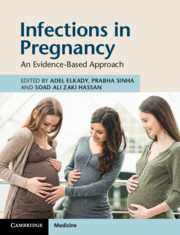Book contents
- Infections in Pregnancy
- Infections in Pregnancy
- Copyright page
- Contents
- Contributors
- Foreword
- Preface
- Section 1 Vaccination
- Section 2 Infections in Pregnancy
- Chapter 2 Viral Hepatitis
- Chapter 3 HIV Infection
- Chapter 4 Herpes Infections and Measles
- Chapter 5 Zika Virus
- Chapter 6 Parvovirus
- Chapter 7 Influenza
- Chapter 8 Cytomegalovirus
- Chapter 9 Dengue Fever
- Chapter 10 Rubella
- Chapter 11 Molluscum Contagiosum
- Chapter 12 Ebola
- Chapter 13 Chikungunya
- Chapter 14 Antibiotics during Pregnancy and Methicillin-Resistant Staphylococcus aureus (MRSA)
- Chapter 15 Gonorrhoea, Syphilis and Lymphogranuloma Venereum
- Chapter 16 Mycoplasma, Ureaplasma, Chancroid, Granuloma Inguinale (Donovanosis)
- Chapter 17 Genital Chlamydia trachomatis and Bacterial Vaginosis
- Chapter 18 Streptococcal Infection
- Chapter 19 Enterococci and Bacterial Infections
- Chapter 20 Listeriosis
- Chapter 21 Urinary Tract Infection
- Chapter 22 Infections and Preterm Labour
- Chapter 23 Appendicitis in Pregnancy
- Chapter 24 Complications Associated with Legal Termination of Pregnancy
- Chapter 25 Tuberculosis
- Chapter 26 Vulvo Vaginitis, Candida (Yeast) Infection
- Chapter 27 Malaria
- Chapter 28 Parasitic Infestation: Protozoa
- Section 3 Postpartum Infections
- Index
- References
Chapter 28 - Parasitic Infestation: Protozoa
from Section 2 - Infections in Pregnancy
Published online by Cambridge University Press: 11 October 2019
- Infections in Pregnancy
- Infections in Pregnancy
- Copyright page
- Contents
- Contributors
- Foreword
- Preface
- Section 1 Vaccination
- Section 2 Infections in Pregnancy
- Chapter 2 Viral Hepatitis
- Chapter 3 HIV Infection
- Chapter 4 Herpes Infections and Measles
- Chapter 5 Zika Virus
- Chapter 6 Parvovirus
- Chapter 7 Influenza
- Chapter 8 Cytomegalovirus
- Chapter 9 Dengue Fever
- Chapter 10 Rubella
- Chapter 11 Molluscum Contagiosum
- Chapter 12 Ebola
- Chapter 13 Chikungunya
- Chapter 14 Antibiotics during Pregnancy and Methicillin-Resistant Staphylococcus aureus (MRSA)
- Chapter 15 Gonorrhoea, Syphilis and Lymphogranuloma Venereum
- Chapter 16 Mycoplasma, Ureaplasma, Chancroid, Granuloma Inguinale (Donovanosis)
- Chapter 17 Genital Chlamydia trachomatis and Bacterial Vaginosis
- Chapter 18 Streptococcal Infection
- Chapter 19 Enterococci and Bacterial Infections
- Chapter 20 Listeriosis
- Chapter 21 Urinary Tract Infection
- Chapter 22 Infections and Preterm Labour
- Chapter 23 Appendicitis in Pregnancy
- Chapter 24 Complications Associated with Legal Termination of Pregnancy
- Chapter 25 Tuberculosis
- Chapter 26 Vulvo Vaginitis, Candida (Yeast) Infection
- Chapter 27 Malaria
- Chapter 28 Parasitic Infestation: Protozoa
- Section 3 Postpartum Infections
- Index
- References
Summary
The name ‘proto-zoa’ literally means ‘first animals’, and early classification systems grouped the protozoa as basal members of the animal kingdom. However, they were recognised as a discrete assemblage on the basis of their unicellularlity and were assigned to the taxon Protozoa (but still invariably figured as the trunk of the animal tree of life).
Protozoa is a parasitic single-celled organism that can divide only within a host organism. Parasites are a diverse group of organisms that account for the majority of human infections.
According to a World Health Organization (WHO) study in 2010, the prevalence was as high as 48.5 million, with 59 724 deaths annually and 8.78 million Disability Adjusted Life Years. The disability-adjusted life year (DALY) is a measure of overall disease burden, expressed as the number of years lost due to ill-health, disability or early death). [EL 1]
Diagnosis may initially be difficult and is based largely on travel history and a variety of tests required (stool, blood tests and imaging) depending on presenting signs and symptoms.
The sequel on maternal and fetal health relies on type of infection, gestational age at presentation, patient’s own natural immunity, early diagnosis, prompt treatment and the prevention of complications.
The decision to treat parasitic infection in pregnancy should be based on risk–benefit ratio. The women should be informed of all potential risks on the fetus and should be allowed to make an informed choice.
Withholding treatment may be appropriate when infection does not pose immediate threat to the life of the mother or fetus in the presence of normal maternal haemoglobin and normal fetal growth.
Use of praziquantel (Biltricide®) medication for helminthic infections, during pregnancy and lactation was historically withheld due to concerns in 1994 of effects on the fetus. However, WHO informal consultation recommended that use of the drug would result in reduced maternal anaemia and perinatal morbidity. [EL 2]
- Type
- Chapter
- Information
- Infections in PregnancyAn Evidence-Based Approach, pp. 164 - 174Publisher: Cambridge University PressPrint publication year: 2019



